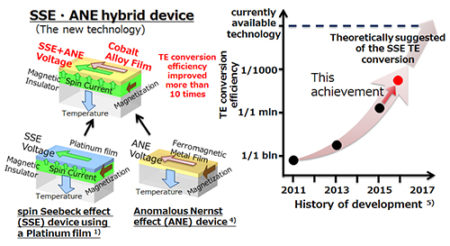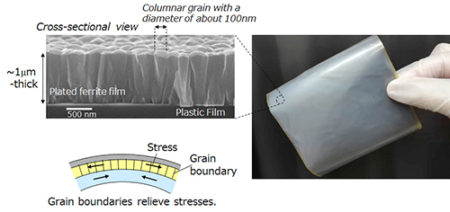Apr
27
Better Waste Heat Energy Recovery With New Thermoelectric
April 27, 2016 | Leave a Comment
Researchers at Tohoku University have announced a new thermoelectric device using cutting edge thermoelectric conversion technology. Thermoelectric conversion technology converts energy abandoned as waste heat back to electric power that could potentially save lost energy.
The new technology, known as the spin Seebeck effect, has conversion efficiency 10 times higher than the conventional method. Although conventional spin Seebeck thermoelectric devices have the advantage of low manufacturing costs and high versatility and durability, their energy conversion efficiency remains an uneconomic disappointment.

Development of a low-cost, high-performance ferromagnetic alloy and significant improvement in thermoelectric conversion efficiency. Conventionally, expensive platinum was used as the electrode material to extract electric power in a spin Seebeck thermoelectric device. This time, new cobalt alloys were developed to replace the platinum. As a result, the cost was significantly reduced. Furthermore, the combination of the thermoelectric effect termed the “Anomalous Nernst Effect,” *4 appearing due to the ferromagnetic properties added to the cobalt alloys and the spin Seebeck effect, have improved the thermoelectric conversion efficiency by more than 10 times. Image Credit Tohoku University. Click image for the largest view.
Soichi Tsumura, General Manager, IoT Device Research Laboratories, NEC Corporation said, “We have improved the conversion efficiency of this spin Seebeck thermoelectric device by more than 10 times because of its newly developed material and device structure. Furthermore, devices made of flexible material, such as resin, have been achieved using a manufacturing process that does not require high-temperature heat treatment.”
“The conversion efficiency of this new spin thermoelectric device has been improved by almost one million times when compared to the earliest device, and has taken an important step towards practical use as a generator element. The achievement of practical use as a heat flux sensor is also in sight,” said Tsumura.

Devices with bending resistance and low heat treatment temperature achieved by new deposition technology. New deposition technology fabricates a fine ferrite film for spin Seebeck thermoelectric devices at 90°C, much lower than the 700°C used with the conventional method. Owing to the decrease in heat treatment temperature, elements can be created on the surface of plastic film, etc., and flexible devices of various shapes are created. Image Credit: Tohoku University . Click image for the largest view.
The team’s research paper has been published in the Nature journal Scientific Reports.
These results were achieved as part of the “Saitoh Spin Quantum Rectification Project” led by Tohoku University Professor Eiji Saitoh. It is funded by the Exploratory Research for Advanced Technology program of the Japan Science and Technology Agency.
The three parties aim to further the research and development of technologies to generate electricity from the large amount of waste heat emitted by things such as plants, data centers and vehicles.
Lets hope the team hit the “home run” as the waste heat loss is a paradoxical problem of escaping energy and wasted hard cash. It a problem very much in need of a good solution.

